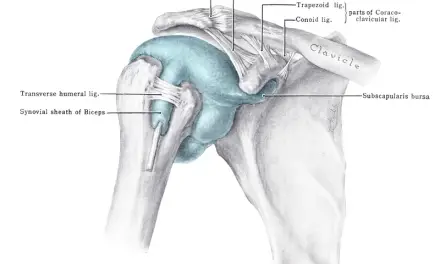A hamstring strain or a pulled hamstring is an injury where one or more of the three hamstring muscles (biceps femoris, semitendinosus, and semimembranosus) get overstretched or torn. It often occurs at the long head of the biceps femoris during the end phase of the leg swing during a sprint. It usually happens toward the hip joint rather than toward the knee, but the painful symptoms may be felt at the back of the knee.
Hamstring strains can put athletes out of commission for many weeks or months, depending on the severity of the injury and recovery time. Field sports, like American football, soccer, and rugby, have higher prevalence of acute hamstring strains than court sports, like tennis and basketball. Likewise, these strains are more common during pre-season than in-season or post-season, and they are common during competition than during practice.
What does a hamstring strain feel like?
A hamstring strain can feel like a sharp pain in the middle of the hamstrings—mainly the biceps femoris—toward the hip attachment, or near the back of your knee. It may also have potential swelling, bruising, and difficulty walking or straightening the leg.
Hamstring strains are classified into:
- Grade 1 (mild strain): minor stretching or microscopic tears of the hamstring muscles; typically causes mild pain and discomfort, but does not significantly impair muscle strength or function.
- Grade 2 (moderate tear): A more significant partial tear of the muscle fibers, resulting in moderate pain, swelling, and noticeable loss of strength.
- Grade 3 (severe tear): A near-complete tear or rupture of the hamstring muscles, resulting in intense pain, significant swelling, and a near-complete loss of muscle function.
- Grade 4 (complete tear): A complete, full-thickness tear or rupture of the hamstring muscles with discontinuity and retraction of the torn muscle fibers.
Interestingly, hamstring muscle tears or injuries do not necessarily cause pain or dysfunction. In a 2016 study of 506 hamstrings from 253 patients with no hamstring or knee pain, 15% of them had a partial tear on both hamstrings and 2% had complete tears on both sides. These tears seem to be more common among older adults than younger adults.
Is it okay to massage a hamstring strain?
Depending on the grade of the strain, massage therapy may provide short-term pain relief.
- For Grade 1 hamstring strains: Massage can be used once the initial acute inflammatory phase (24–48 hours) has subsided. It may reduce pain and muscle spasms and minimize scar tissue formation.
Gentle techniques, such as Swedish massage, lomi lomi, and similar light-touch massage, should be used. - For Grade 2: Massage should be avoided in the initial acute phase until swelling and inflammation subside. After the acute phase, gentle massage can be used.
- For Grades 3 and 4: Massage should be avoided in the early stages. Check with your physical therapist or another healthcare professional before getting a massage.
Light massage may be introduced several weeks into rehabilitation once significant healing has occurred. This would be up to your healthcare professional.
Massage should be performed by a qualified therapist who can properly assess the injury and apply appropriate techniques. Communication between you and the therapist is crucial to avoid exacerbating the injury. If the massage therapist insists on using aggressive techniques or does not listen to you, find another therapist.
Related: Differences Between a LMT and CMT
Related: Sprain vs Strain: How to Tell the Difference
Hamstring strain causes
Risks of getting a hamstring strain are primarily from various biomechanical and physiological factors. These include:
- Eccentric muscle contraction of hamstrings
- Fatigue
- Previous hamstring and posterior knee injuries, such as a PCL tear or hamstring tendinitis
Eccentric contraction
Eccentric contraction is where a muscle lengthens under stress. If you were to do a prone hamstring curl exercise, an eccentric contraction is where you extend your knees as you lower the weight in a controlled manner. When you run, your hamstrings decelerate during the end phase of the leg swing. They also eccentrically contract where the hamstring tendons reach their highest amount of strain. It is this phase of movement that many researchers on hamstring strain investigate.
While most clinicians think that the eccentric contraction of the hamstring is where most of the strains occur, research says otherwise.
While most of the research emphasizes the final phase of a leg swing during a run, earlier research on hamstring strain hypothesized that the early phase of a leg swing has the greatest risk of getting a strain. Dr. John W. Orchard, who is a sports physician at the University of Sydney, is one of the proponents who supported the early leg swing phase. He argued in an editorial in 2012 that although the hamstrings do work the hardest during the end phase, the inertia that created the tension is not the force that causes the strain.
“It is a strong force (moment, torque) in the opposite direction (causing hip flexion and knee extension) that strains a hamstring, which is most likely to be due to [ground reaction force],” he wrote.
He pointed out that there is no direct evidence to support the eccentric contraction idea, such as a video that shows an actual tearing of the hamstring muscle or tendon — as he had demonstrated with a calf muscle strain on video in 2002.
However, perhaps there is no clear cut answer to this problem. Researchers from China stated that both phases of the leg swing are “potentially hazardous times for injury during high-speed running.”
Rather than looking at both phases as separate moments, Liu et al. suggested in 2017 that these two phases should be considered as a “swing-stance transitional period.” This means that this movement is continuous, not just a snapshot of a moment in time. The hamstrings flex the knee and extend the hip throughout the running gait.
In a 2019 narrative review the researchers cited several “gaps” of knowledge regarding this part of hamstring strain research:
- Lack of studies among elite athletes
- Lack of direct measurement of hamstring muscle stimulation during high-speed running,
- The need to look at how hamstring muscles and tendons each contribute to lengthening and velocity
- Lack of prospective studies that examine the relationship between running mechanics and hamstring injury
Currently, the most recent consensus still weighs highly on eccentric hamstring contraction during the late phase of the leg swing cycle, as a 2020 systematic review of 26 studies indicated. The researchers, however, warned that the conclusions were based on “estimations of the hamstring injury mechanism,” not the injury “per se.” Some of these studies had subjects running on a treadmill at a slower pace than an actual sprint on a grassy field where most of the hamstring strains happen. So, a better way to edge closer to the truth would be to improve study designs and get larger sample sizes, the researchers suggest. This would likely further reduce the research bias.
Furthermore, an international team of researchers suggested that eccentric contraction is not enough to explain how this can cause a hamstring strain. The team highlighted that although the number of research about hamstring strains has increased, “the potential injury mechanisms are not well defined, and injury incidence seems to have either remained about the same or even increased.”
They argued that these studies were done from computer simulations and prediction models, not live humans, which do not account “all aspects of muscle tissue that influence function” during a run or sprint, such as anatomical variability and tissue adaptation to mechanical stress.
There is still much speculation on whether the fascicles in the hamstring muscles lengthening during the end phase of the leg swing, as well as potential errors in measuring the stretch of the tendon tissues. These errors, the researchers suggested, would include a lack of account for muscle fatigue.
They wrote that if one of the hamstring muscles is working harder than the others, “its metabolic demand would be higher and fatigue would develop sooner.”
Fatigue
Fatigue may reduce the hamstrings’ ability to generate force and absorb eccentric loads during the late swing phase of sprint. It would also change the coordination of muscle contraction, which may cause a chain reaction of altered running mechanics, such as:
- Reduced activity in the rectus femoris muscle
- Increased activity in the semitendinosus and biceps femoris
- Decreased hip extension
- Increased knee extension
While there’s little evidence that such changes in running mechanics may significantly increase the risk of getting a hamstring strain, it is suggested that a reduced running efficiency (such as adopting an anterior pelvic tilt during a fatigue) and greater force upon the joints may likely increase such risk.
Flexibility
The lack of good flexibility of the hamstrings may seem like an obvious cause of a strain, but there’s no strong evidence to support this.
One 2012 literature review found mixed results regarding whether a lack of flexibility and a reduction of muscle length could cause a pulled hamstring. In one study, athletes from the Australian Football League (AFL) with a history of hamstring strains “may have shorter optimum hamstring muscle lengths” than those with no such history. However, a prospective study of 44 sprinters in Hong Kong found no “significant difference in the knee flexion angle for the peak knee flexion torque” between the injured and non-injured during the pre-season.
For general hamstring and knee flexibility, there is “inconsistency” among various studies, which is caused by different methods and factors used, such as different control groups, control of risk factors, and how injury risks were measured.
A 2019 study of 570 young Gaelic football players and hurdlers found that poor hamstring flexibility and previous injury “were unable to predict those at risk of sustaining a hamstring strain…”
Looking at the bigger picture, a 2020 systematic review of 78 athletic studies found that the degree of flexibility, mobility, and range of motion in the hips, knees, and ankles showed no clear relationship with the risk of getting a hamstring strain.
Previous hamstring injury
As with most types of muscle and joint injuries, having a history of hamstring strains would increase your chances of sustaining another pulled hamstring—in addition to older age, a history of having hamstring strains, ACL tear, and calf strain.
This is similar to a previous systematic review in 2014 that “revealed a relationship between previous injury and re‐injury in each lower extremity injury that was studied.” These injuries include hamstring strains, ACL injury, Achilles tendon injury, and ankle sprains.
The researchers summarized that elite Australian football players were more than four times more likely to pull another hamstring than their peers who never had such injury. Also, about 27% of all hamstring strains in the AFL were caused by previous hamstring strains. However, the researchers don’t know if the reinjuries were due to “accumulated microscopic muscle damage or the presence of a single injurious event.”
Treatments
Grade 1 and sometimes grade 2 hamstring strains can be treated and managed without surgery.
Erickson and Sherry proposed a three-step general guideline for hamstring strain rehabilitation:
- Minimize pain and edema; restore some neuromuscular control and function with exercises at slow speeds
Prevent excessive scar tissue formation while “protecting the healing fibers from excessive lengthening - Increase exercise intensity and speed gradually to the patients’ ability and tolerance, start eccentric strength training;
- Integrate high-speed exercise training and sports-specific training.
Surgery may be needed if there is symptomatic tendon avulsion, which is a hamstring tendon tearing off a piece of the bone at one of its attachments. Such an injury prevents athletes from returning to compete, and the results of surgery and conservative treatments are mixed.
In a 2014 study by Hoffman et al., about 30% of the 19 older patients with a hamstring tendon avulsion were unable to play at their pre-injury level, and about half of them “regretted not having undergone surgical treatment.”
The researchers suggested that hamstring avulsion — especially at the long head of the biceps femoris — should be surgically repaired “as early as possible,” ideally within two weeks after the injury. This can minimize the risks of further complications of the hamstring tendons and muscles and the sciatic nerve.
In fact, sciatica and weakness of the hip extensors may develop due to nerve problems associated with delayed surgery, including the nerves in the back of the thigh, such as the posterior femoral cutaneous nerves and the lower gluteal nerve).
As with most treatments, surgical or otherwise, consult with your physician or another qualified medical professional. Do not substitute this article for medical advice.
Hamstring exercises
Exercise has been shown to minimize the effects of scar tissue formation and injury recurrence, such as strengthening and stretching programs. Both concentric exercises (shortening of muscle fibers under resistance) and eccentric exercises (lengthening of muscle fibers under resistance) can improve recovery, as well as open-chain exercises—where your body is in a fixed position and your limbs are free to move—like a hamstring curl on a machine.
While several individual trials have found that eccentric training is better than concentric training for muscle power and general muscle strength, one 2008 systematic review of seven studies found that there is limited evidence that this is true. Because of study limitations, such as lack of control groups, eccentric training not studied in isolation, and small sample sizes, the individual trials may likely have false positives.
Another systematic review in 2020 that examined the biceps femoris found similar results, given that there is “limited to moderate evidence” that eccentric strength training can increase muscle fascicle length. There was also conflicting evidence that eccentric training is better than concentric training for general strength development.
One exercise researcher from the University of Calgary in Canada argued that hamstring injuries may “have nothing to do with eccentric loading and mechanics of the muscles in sprint running.” Dr. Walter Herzog proposed other factors that might influence a hamstring strain, such as a “loss of motor control” or a “lack of focus when sprinting.” These factors are also psychosocial in nature, so they should be included when considering treatment for hamstring strains.
“Maybe hamstring injuries are not mechanically mediated, not caused by eccentric contraction, but caused by a small change in hamstring activation when attempting to come from behind in a sprint race, or when tightening up in a losing position,” Herzog concluded.
Finding the right treatment for you and finding out the mechanisms and risk factors of getting a hamstring strain are still challenging for scientists and clinicians, even though this topic has been researched for decades. Perhaps a better approach — if not the best — is to have a combined and adaptable intervention that is borrowed from the biopsychosocial model of pain and health.
Who often gets a hamstring strain?
While hamstring strains can occur in any sport or activity involving running and explosive leg movements, track and field athletes, soccer and American football players, and basketball players are among the most frequently affected due to the extreme demands placed on their hamstring muscles during competition and training.
For example, a three-year-study of injuries from track and field athletes at the Penn Relays found that hamstring strains make up about 24% of all 489 treated injuries. Among lower-body strain injuries, hamstring strains accounted for more than 75%. In this population, older athletes (ages 40-plus) and men are more likely to sustain a hamstring strain than younger athletes and women, respectively. Also, those who participated in longer relays (400 meters) have a higher risk than those in shorter relays (200 and 100 meters).
In American football, 10 years of data from a 2008 study found that hamstring strains ranked number two after knee sprains among players in the National Football League camp.
Meanwhile, about 37% of soccer injuries are hamstring strains and other hamstring injuries—based on nearly 3,000 injuries reported from 2001 to 2009 among 51 teams in the Union of European Football Associations.
Dancers (classical, modern) also have been shown in a Swedish study to sustain similar acute hamstring strains as other athletes because of the flexibility strain they do during practice or a performance. Interestingly, the sprinters got a strain while they were sprinters while the dancer got a strain from slow stretching exercises.
Currently, little is known about how often non-athletes get a hamstring strain.
While hamstring strains are biological in nature, it can influence your behavior, which can affect how long and how well you recover and resume daily activities. A thorough understanding of hamstring strain from a biopsychosocial perspective should help maximize recovery and save time (and money) on treatments.
Further reading
What Does a PCL Tear Feel Like?
How Massage Can Treat Chronic Pain
A native of San Diego for nearly 40 years, Nick Ng is an editor of Massage & Fitness Magazine, an online publication for manual therapists and the public who want to explore the science behind touch, pain, and exercise, and how to apply that in their hands-on practice or daily lives.
An alumni from San Diego State University with a B.A. in Graphic Communications, Nick also completed his massage therapy training at International Professional School of Bodywork in San Diego in 2014.
When he is not writing or reading, you would likely find him weightlifting at the gym, salsa dancing, or exploring new areas to walk and eat around Southern California.






